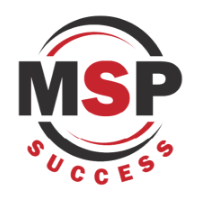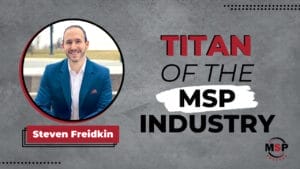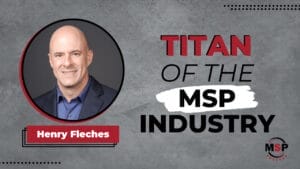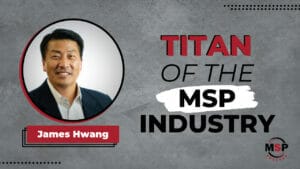Adam Eiseman says Lloyd Group’s nimble-minded attitude has allowed them to pivot sales and marketing quickly at key moments to cause huge growth year-over-year. See what he says are the keys to MSP success.
Note: This article is taken from a live interview and has been edited for clarity and length.
CEO Adam Eiseman credits Lloyd Group’s success to constantly evolving with both the rapidly changing MSP space and the company’s willingness to pivot sales and marketing initiatives with the growth of the company. Now his company is focused on the mid-market and has seen a 19% growth over last year. Moving into the future, Adam keeps an eye toward market differentiation and honing his customer base.
Robin Robins, founder of MSP Success Magazine and Big Red Media, spoke with Adam to uncover how Lloyd Group was able to quickly navigate choppy waters by staying ahead of the current. Adam shares why having a forward-thinking mindset is necessary to successfully accelerating an MSP to next-level growth. He says it’s crucial for any MSP who wants to scale up and carve out their own place as a Titan in the industry that they see change before it happens – and act on it.
Robin Robins: Tell us a little bit about Lloyd Group.
Adam Eiseman: Lloyd Group was founded 28 years ago as a typical VAR integrator, and in 2001 we became an early mover in the MSP space. Although transitioning our clients from traditional hourly billing to managed services took us three years to do, it was one of the critical things that was a big factor in our success, and doing it over a few years allowed us to focus on the MSP space and grow.
From then up until about 2015, we were focused on the traditional legacy MSP space, which is 100 or less employee clients, generally 50 or less small businesses, one single location and not particularly complex. During that time, we also built a cloud presence. Then, in 2015, we made a few big key decisions.
One was to end our private cloud, because we did not see ourselves competing with Microsoft, AWS or Google. We felt that moving our clients to a public or semi-public cloud made sense. It was a big sacrifice of margin, and it was a tough choice. But we saw the long-term benefits and began along that path.
We made another choice in 2015 to grow out a security practice because we saw that as a need. We shifted our talent and assets from our data center and private cloud offering to building out the new security practice. And finally, at the same time, as a third pillar for growth, we decided to move up into the mid-market space to focus on clients with at least 100 employees up to a few thousand employees. Even though that meant effectively retooling our business, we knew we could do it since it was similar to what we did when we went into the MSP space 15 years prior.
These days we’re seeing significant growth because of our security practice (which is growing in double digits year-over-year, from the standpoint of both security projects and security recurring revenue), and our overall managed services revenue is growing exponentially. We’re adding clients in the 200-to-500 employee space, and we’re targeting companies that are PE (private equity) backed. It’s what is leading our growth – and a whole set of interesting new challenges.
Robin: Are you still servicing any of those small SMBs that are the smaller sub-100?
Adam: We are, and it’s a part of our practice. If you look at our client base from a numeric standpoint, it’s still a large portion of our business. But from a new business standpoint and revenue standpoint, it’s a shrinking piece of our business. We have minimums now that discourage it (our minimum monthly spend is currently at $3,000 and increasing). Will we take on a five-person family office? The answer is yes. But, generally, they’re paying a very high per-user cost to get the level of service. This is because one of the things we’ve found is that the skills and talent we’ve developed and hired in the mid-market have also made us more attractive to the smaller SMB clients too. If we’re seeking clients in the sub-100 employee space, it’s with ones that are willing to invest in IT. Once that high level of service and expertise is set, the client believes we can help them grow because we understand the needs of fast-growth companies – and they’re willing to pay more for it.
Robin: But the mid-market, private-equity-backed fast growth is really your niche – that’s what I’m hearing, right?
Adam: Not necessarily always fast-growth (though we like that), but more so measured growth. We’re very selective in who we take on as a client. One of the things we found in this industry is that attrition is negative growth and is the #1 cause of pain. We like to take on clients that aren’t shopping price or aren’t shifting because of the pain of the moment, but are looking for a long-term relationship. No one ever calls an MSP because they’re having a good day. A client is going to be in pain at some point throughout your relationship with them, and they need to be looking for somebody that they know is going to be there for them through the long haul.
Robin: Last year you grew about 19%. Where do you think that growth is coming from? Where do you see the big opportunities?
Adam: Up until last year, we saw most of our growth came from cloud services. We got out of the private cloud business. We sacrificed a lot of margin, but what we actually took on was a tremendous amount of growth and the ability to scale without making CapEx investments. So, our cloud practice actually grew by about four times while our margin shrunk. We ended up with similar to higher-dollar margins on a less risky, less capital-intensive cost structure. We’re now seeing that we’re starting to grow at a more moderate pace because there’s less adoption. Where we’re seeing growth is in bringing a client on at 200 people and then they scale up to 800.
Real growth is in two areas. One is security. We’ve been successful in the past two years of converting security projects into a recurring service. The other place where we’re seeing growth is in what we call Lloyd Care, which is our core managed services offering. And that simply comes down to adding users, locations and devices that you support.
Robin: Most of the growth is coming from existing customers who are expanding into other services, correct?
Adam: The majority of them are consuming more services, especially around security. We are seeing tremendous growth from new clients that we’ve added in the past two years and are continuing to add that come on at a larger size.
Robin: What things should MSPs be doing now so that they’re prepared in the next two to three years?
Adam: We all have room to grow from the standpoint of security. That is an ever-evolving area, and I think most MSPs are still challenged there. I think there are advantages for MSPs becoming SOC 2 compliant as they continue to invest not only in security practices but in their own infrastructure and security practices. That’s a necessity. And without that, I think you’re going to shrink, or you’re going to take on the types of clients that are not necessarily the most profitable.
The other area we’re looking at is the mid-market, which for us is a big focus. We’re able to offer our clients business-level expertise as opposed to just keeping the lights on, and there’s increased value there. It’s not easy to get into the mid-market, but I think really that’s where most of the opportunity is right now.
Robin: Let’s talk about some of the challenges. There’s hyperinflation and it hasn’t come down, so the cost of everything has gone up. There’s a labor shortage. What are you seeing out there as the biggest challenges and how are you overcoming them?
Adam: We had a little bit of a challenge around inflation and growth and wages. We did go and increase our fees to our clients last year because of higher labor costs. That’s never an easy conversation to have, but if you’re providing really good value and your fee increases are consistent with what’s going on in the environment, it’s something that can be done.
From a labor perspective, we moved early on pre-Covid to a very liberal work-from-home policy to give staff work-life balance. We rolled out a number of concepts that were focused on giving the people in our community the ability to make their kids’ soccer games, to have dinner with their partner and to enjoy their hobby and their life. And that, along with hiring great managers and moving into interesting markets, has helped us, I think, with retention. And with satisfaction.
Robin: What other challenges do you think just you or other MSPs are facing right now?
Adam: I think, at our size and where we are, that the #1 challenge is some of the rollups. Supporting larger clients and having the capability to do it. We’ve had opportunities that we’ve lost recently because we weren’t quite big enough. Even though we have a nationwide presence and we’re supporting clients overseas and we’re 24/7/365, it’s a much safer bet to go with a larger organization that has a deeper bench.
I also think as an MSP you need to decide what your strategy is, who you’re going to be and stay true to that. Who’s the right fit for your business? It’s about differentiating. It’s really hard to differentiate in the legacy space. You can differentiate on size, you can differentiate on expertise, but at the end of the day, it’s really going to come down to price. At least, that’s what we’re seeing.
Robin:True. Everybody’s offering essentially the same thing, but there’s always a way to compete.
Adam: Right, you’ve got to carve out your niche, your sweet spot, and really hone yourself for that particular sweet spot. Because otherwise you’ve just become part of the sea. It’s a sea of sameness out there. It’s really the biggest challenge. You have to be disciplined to your differentiators once you’ve decided what they are.






